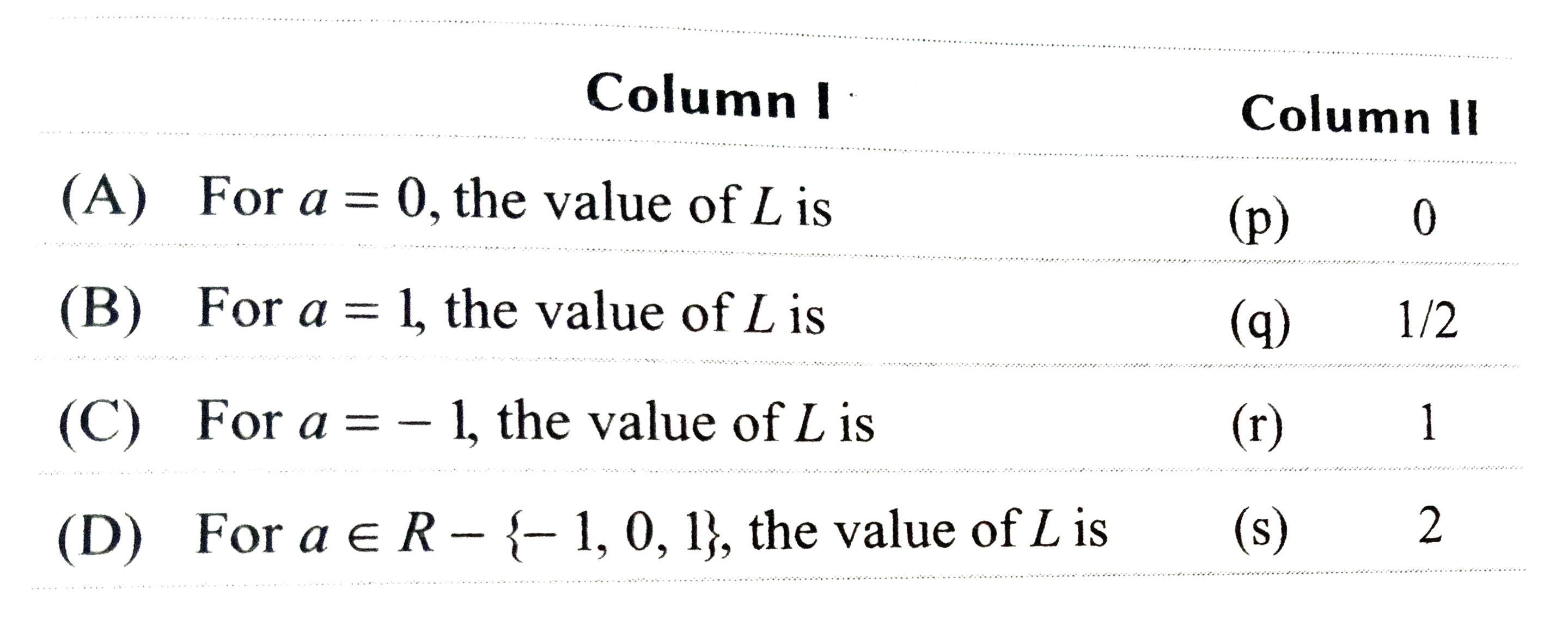The ratio in which the curve y=x2 divides the region bounded by the curver: y=sin'(πx2) and the x-axis as x varies from 0 to 1, is :
2:π
1:3
3:π
(6−π):π
The correct Answer is:D
To solve the problem, we need to find the ratio in which the curve y=x2 divides the area bounded by the curve y=sin(πx2) and the x-axis from x=0 to x=1.
Step 1: Find the area under the curve y=sin(πx2) from x=0 to x=1.
The area A1 can be calculated using the definite integral:
A1=∫10sin(πx2)dx
Step 2: Compute the integral for A1.
Using the substitution u=πx2, we have du=π2dx or dx=2πdu. The limits change as follows:
- When x=0, u=0
- When x=1, u=π2
Thus, the integral becomes:
A1=∫π20sin(u)⋅2πdu=2π(−cos(u))π20=2π(−cos(π2)+cos(0))
Calculating this gives:
A1=2π(0+1)=2π
Step 3: Find the area under the curve y=x2 from x=0 to x=1.
The area A2 can be calculated using the definite integral:
A2=∫10x2dx
Step 4: Compute the integral for A2.
Calculating this integral gives:
A2=(x33)10=133−033=13
Step 5: Find the ratio A1A2.
Now we can find the ratio of the two areas:
A1A2=2π13=2π⋅3=6π
Step 6: Express the ratio in the required format.
The ratio A1:A2 is:
A1:A2=6−π:π
Final Answer:
Thus, the ratio in which the curve y=x2 divides the region bounded by the curve y=sin(πx2) and the x-axis is:
6−π:π
- When x=0, u=0
- When x=1, u=π2
Topper's Solved these Questions
- DEFINITE INTEGRATION & ITS APPLICATION Book:RESONANCE ENGLISHChapter:DEFINITE INTEGRATION & ITS APPLICATION Exercise:Exercise 2 Part - II
Explore 17 Videos
- DEFINITE INTEGRATION & ITS APPLICATION Book:RESONANCE ENGLISHChapter:DEFINITE INTEGRATION & ITS APPLICATION Exercise:Exercise 2 Part - III
Explore 25 Videos
- DEFINITE INTEGRATION & ITS APPLICATION Book:RESONANCE ENGLISHChapter:DEFINITE INTEGRATION & ITS APPLICATION Exercise:Exercise 1 Part-III
Explore 1 Video
- COMBINATORICSBook:RESONANCE ENGLISHChapter:COMBINATORICSExercise:Exercise-2 (Part-II: Previously Asked Question of RMO)
Explore 5 Videos
- DPPBook:RESONANCE ENGLISHChapter:DPPExercise:QUESTION
Explore 656 Videos
Similar Questions
∫423x2+1(x2−1)3dx=λn2 where λ,n∈N and gcd(λ,n)=1, then find the value of λ+n
View Solution∫∞0x(1+x)(1+x2) dx equals to :
View SolutionLet limT→∞1T∫T0(sinx+sinax)2dx=L, then

View SolutionFind the number of all 6-digit natural numbers such that the sum of their digits is 10 and each of the digits 0,1,2,3 occurs at least once in them.
View SolutionCounting numbers have fascinated human mind from time immemorial. The first set he seems to have pondered about is the set of natural numbers, N Various subsets of this set were diffined. Note worthy among them are
Prime Number :- if a natural number has exactly two divisors it is called a prime number. Yet another way Simple examples are 2,3,5,7,...........
{2,3} in the only set of consective primes.
Composite numbers :- A natural number having more than 2 divisors is called a composite number. Simple examples are 4,6,8,9,10,..........
Note that 1 is neither prime nor composite.
Coprime or relatively prime numbers :- A pair of natural numbers is acalled a set of coprime numbers if their highest common factor (HCF) or greatest common divisor (g.c.d.) is 1. For example 8 & 5 are co-prime
Note that these two numbers need not be prime.
More over 1 is coprime with evert natural numbers.
a prime number is coprime with all natural numbers which are not it's multiple.
Twin Prime :- A pair of primes is called twin primes if their non-negative difference is '2' For example {3,5},{5,7},(11,13} , .........
Based on above difinitions solve that following problems
Number of prime numbers less than 10 is
(a) 2 (b) 3 (c) 4 (d) 5
View SolutionFind the area bounded by the curves y=sqrt(1-x^(2)) and y=x^(3)-x .Also find the ratio in which they-axis divided this area.
View SolutionFind the area of the region enclosed by curves y=sinx and y=cosx as x varies 0 to π2 with x-axis
View SolutionThe ratio in which the area bounded by the curves y2=xandx2=y is divided by the line x=12 is
View SolutionThe area of the region bounded by the curve y=sinx between the ordinates x=0, x=π2 and the X−axis is
View SolutionThe area of the region bounded by the curve y = sin x between the ordinates x=0,x=π2 and the X-axis is
View SolutionThe ratio in which the curve y=x2 divides the region bounded by the curver: y=sin'(πx2) and the x-axis as x varies from 0 to 1, is :
View Solutionसिद्ध कीजिये कि वक्रो y=sinx तथा y=sin2x, x = 0 व x=π3 तथा x - अक्ष से सीमाबद्ध क्षेत्रफलों का अनुपात 2 : 3 है |
View SolutionFind the area of region enclosed by curves y=sinπx,y=x2−x,x=2
View Solutionवक्र y=logx,y=0,X-अक्ष और x = 2 से घिरे क्षेत्र का क्षेत्रफल ज्ञात कीजिए ।
View SolutionFind the area of the region bounded by the curves, y=logex,y=sin4πxandx=0.
View SolutionConsider the curves C1=y−4x+x2=0 and C2=y−x2+x=0
The ratio in which the x-axis divide the area of the region bounded by the curves C1=0 and C2=0 is
View Solution
